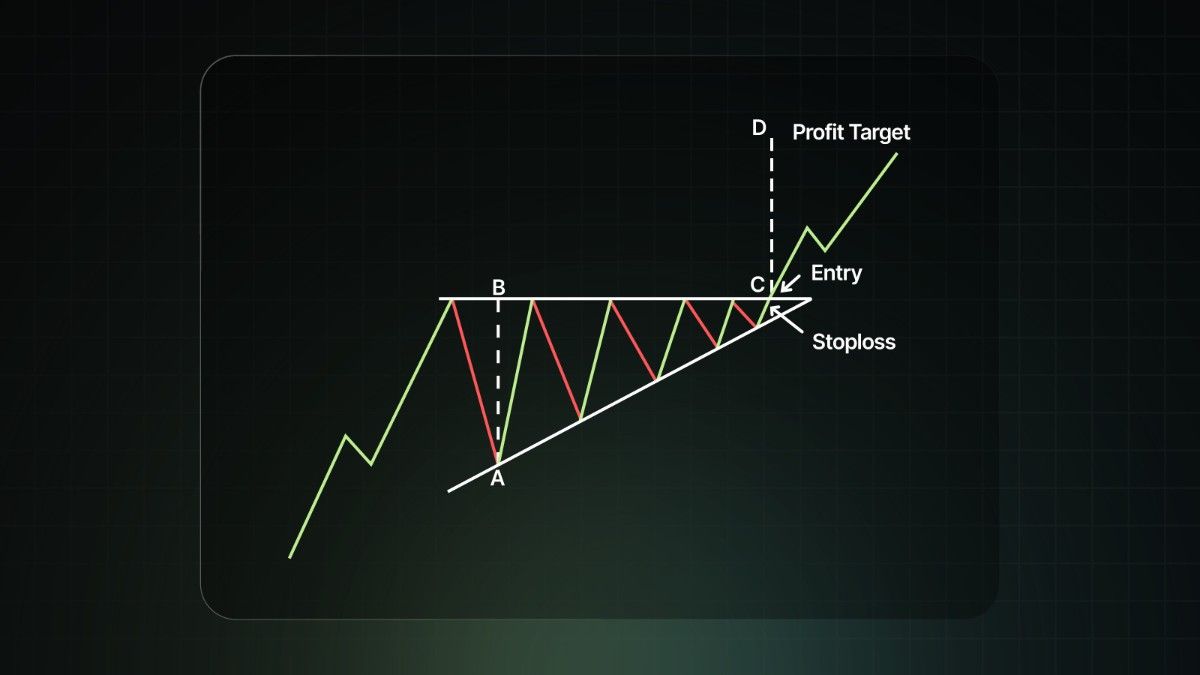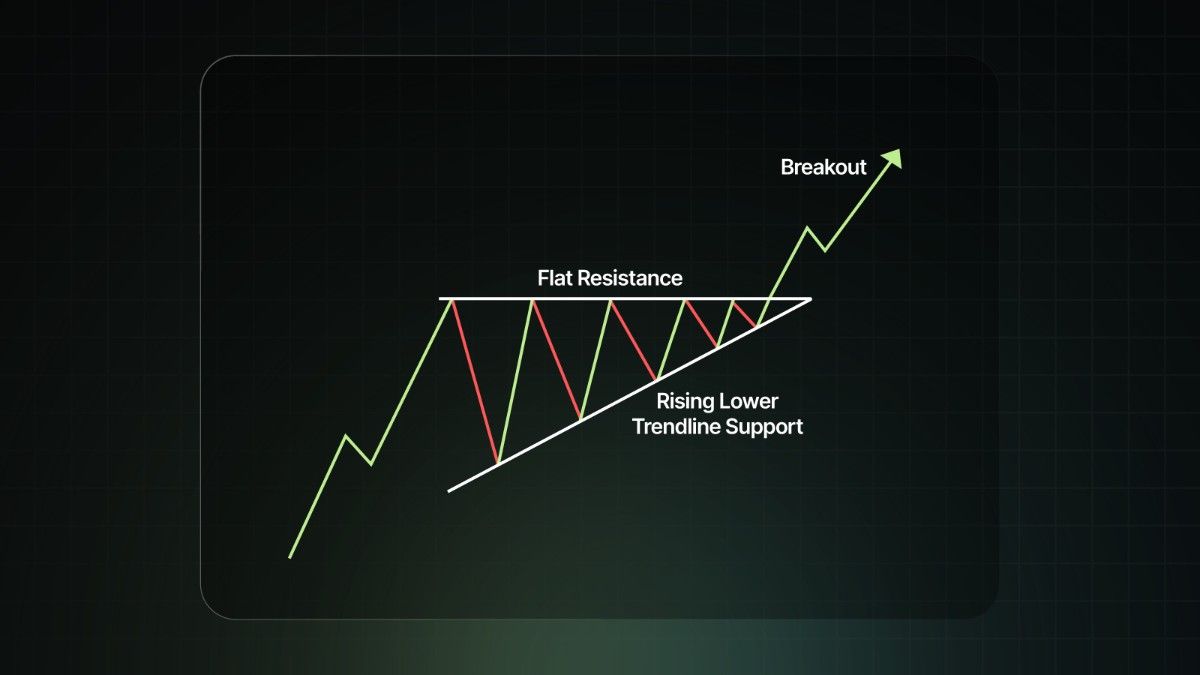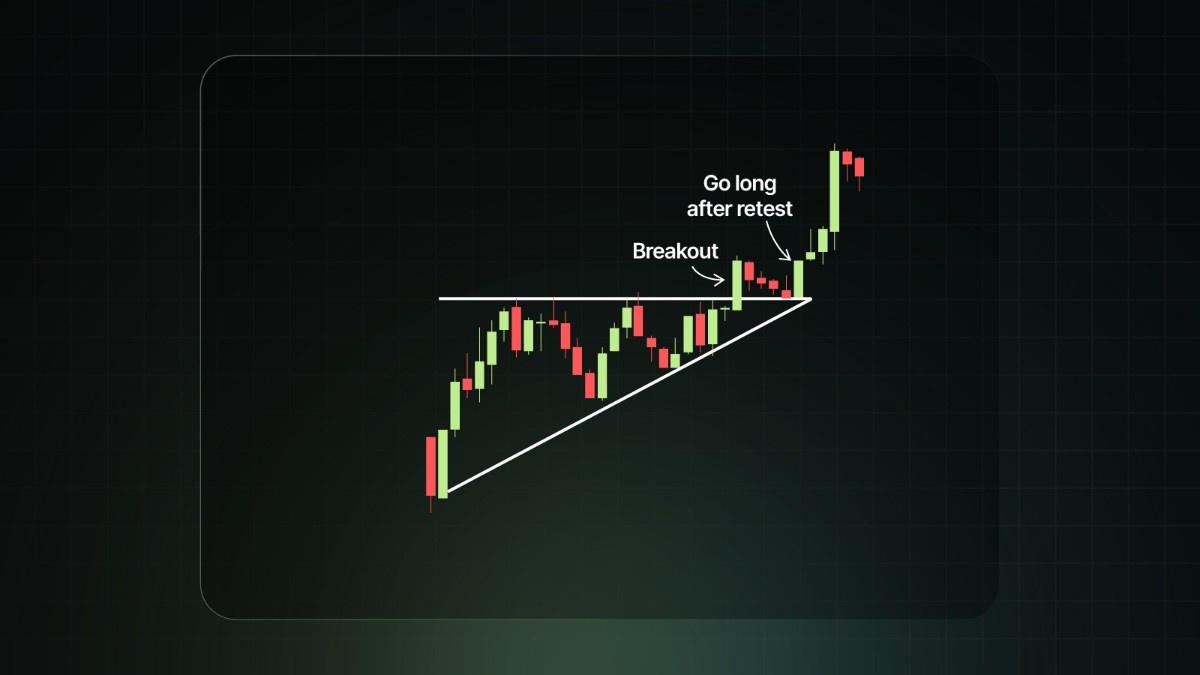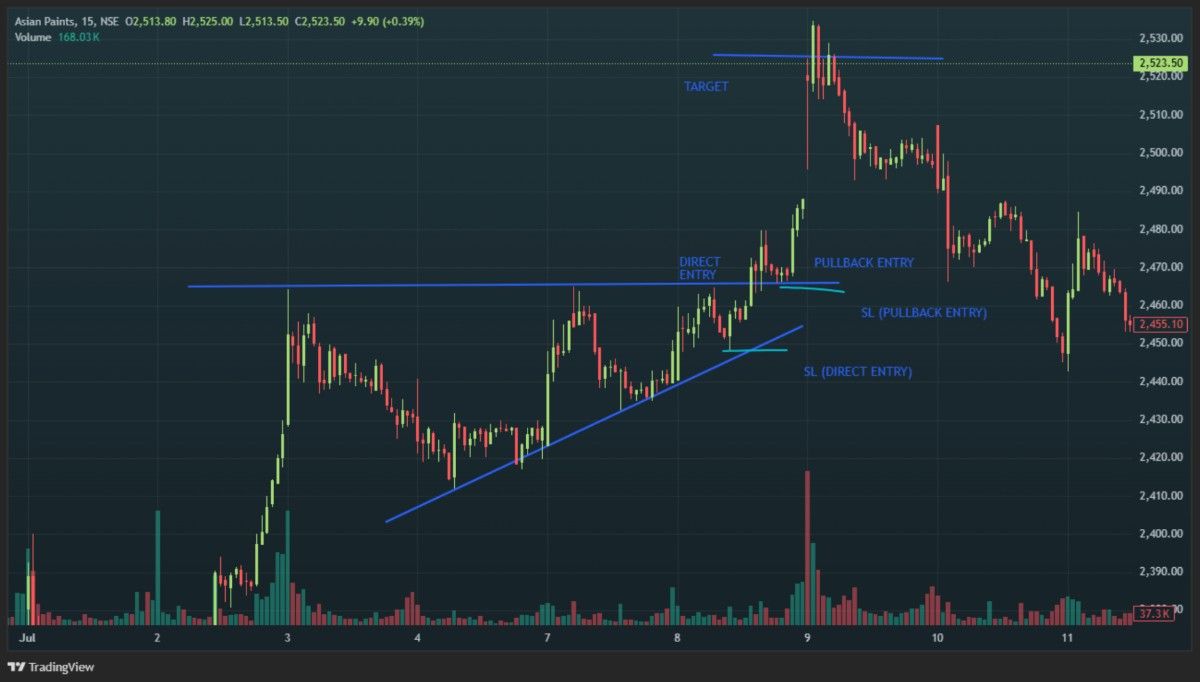Often, different asset classes, such as indexes, commodities, and currencies, exhibit patterns that repeat over time. These are called trading patterns. While many patterns might not be worth trading, the triangle pattern is different.
Triangle patterns are extremely strong patterns, providing excellent entry points for traders. Triangle patterns look like continuation or consolidation chart formations. The reason they are called “triangle patterns” is that they look like a triangle. They help traders anticipate breakout directions.
There are three major kinds of triangle patterns - Ascending, Descending and Symmetrical.
Let us start with the basics of the ascending triangle pattern. Here’s how an ascending triangle pattern looks like -

The market is in an uptrend, but at the same time, it is facing resistance. This leads to profit booking and a pullback. The bulls again try to go up, but are met with resistance. This resistance occurs multiple times and happens around the same horizontal level at the top, and every time there is a pullback.
However, the pullback is not as strong as the previous one, and the low reached is higher than the previous low. This formation can occur multiple times, resulting in a rising trendline (higher lows) at the bottom. This suggests that the buyers are becoming stronger with each pullback.
From the psychological perspective, the sellers are trying to defend at a fixed resistance zone. However, the buyers are not giving in and are, in fact, becoming stronger as time goes on. This proves that at every step, the buyers can reverse the downfall from a higher price. This leads to pressure building, and finally, the buyers can break out on the upside with huge volumes.
The triangle pattern provides excellent and profitable bullish entry opportunities for traders. There are two main kinds of strategies.
The first is the direct breakout at the resistance level. This is a more aggressive entry. On the other hand, there can also be a pullback strategy, where the traders wait for the market to retest the resistance zone (which has now converted into a support zone) and take the entry afterwards.
This is how the two entries look. The following infographic depicts an aggressive entry at the breakout directly -

Conservative traders typically wait for the retest of the resistance line and then take entry: -

Once the entry is made, a stop loss should be added. The stop loss will depend on the kind of entry taken. Suppose you make an aggressive entry, then the stop loss could be the last swing low.
On the other hand, in the case of a retest entry, the stop loss is typically small and just below the retest low candle.
Finally, the target can be based on the risk-to-reward ratio. Usually, a good risk-to-reward ratio of 1:3 is maintained while trading ascending triangle patterns.
Here is the summary of both entries:
|
Factor |
Breakout Entry |
Retest Entry |
|
Entry Point |
Enter right after the price closes above the resistance with volume |
Enter when price retests broken resistance as new support |
|
Stop-Loss |
Below breakout candle or last higher low |
Below retest the low or rising trendline |
|
Target |
Height of the triangle projected upward from the breakout |
Same height projection or next resistance level |
|
Pros |
Captures full move early |
Safer, reduces false breakout risk |
|
Cons |
Higher risk of false breakout |
May miss trade if no retest happens |
Let's take an example of Asian Paints on a 15-minute timeframe on 8 Jul 2025.
A clear ascending triangle formation occurs with 3 points touching at the resistance zone. Then there was a breakout green candle, which could have given a good entry to traders. For conservative traders, there was a slight retest of the same resistance zone, and an entry could have been initiated. The stop-loss of both types of entries is also shown in the figure. Asian Paints made a significant move the next day, and all targets were hit comfortably, with a risk-to-reward ratio of more than 1:3.

Apart from the ascending triangle, there are symmetrical and descending triangle patterns as well. Here are the differences between them:
|
Aspect |
Ascending Triangle |
Descending Triangle |
Symmetrical Triangle |
|
Upper Line |
Flat (horizontal resistance) |
Downward sloping (lower highs) |
Downward sloping (lower highs) |
|
Lower Line |
Rising (higher lows) |
Flat (horizontal support) |
Rising (higher lows) |
|
Bias |
Bullish (buyers gaining strength) |
Bearish (sellers gaining strength) |
Neutral (breakout can go either way) |
|
Breakout Expectation |
Usually upward |
Usually downward |
Depends on trend direction |
|
Market Psychology |
Buyers press higher each time, sellers stuck at resistance |
Sellers push lower each time, buyers defend support |
Buyers and sellers compress, waiting for a breakout |
|
Reliability |
Strong in uptrends |
Strong in downtrends |
Reliable only with volume confirmation |
Always remember that no pattern is foolproof and no pattern works all the time. Here are some limitations of an ascending triangle:
An ascending triangle is considered a very strong bullish continuation pattern. Its reliability increases with volume and trend confirmation. Other indicators might be used to make it even better. The best part about the pattern is that it offers high risk for a high reward. However, it should always be used with risk management and supporting indicators.
Frequently Asked Questions
Q1. What does an ascending triangle pattern indicate?
An ascending triangle pattern is a bullish consolidation pattern. It signals a good entry just before a likely breakout upward.
Q2. Is it bullish or bearish?
It is generally a bullish pattern, especially in an uptrend.
Q3. How to differentiate it from other triangles?
There are three kinds of triangles. To find an ascending triangle, look for flat resistance and higher lows.
Q4. What are the best indicators to confirm it?
Some of the best indicators to give confirmation are volume (rising on breakout), RSI (strength), MACD (bullish crossover) and supertrend.
Q5. Can the breakout fail?
Yes, false breakouts can occur, so confirmation with volume and a stop-loss is essential.

Vaishnavi Tech Park, South Tower, 3rd Floor Sarjapur Main Road, Bellandur Bengaluru – 560103, Karnataka
© 2025 915.trade by Groww. All rights reserved.